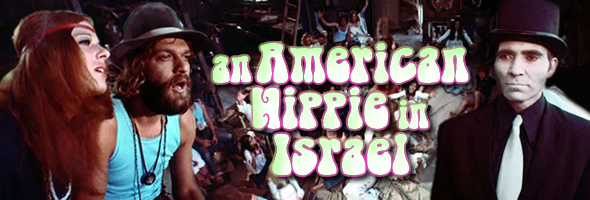
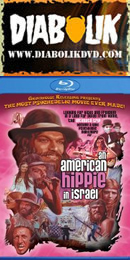

Color, 1972, 93m.
Directed by Amos Sefer
Starring Asher Tzarfati, Shmuel Wolf, Lily Avidan, Tzila Karney
Grindhouse Releasing (Blu-ray & DVD) (US R0 NTSC) / WS (1.78:1) (16:9)
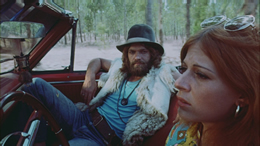
Behold the one-of-a-kind adventures of Mike (Double Team's Tzarfati), a wandering
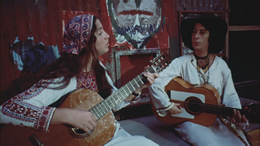 Vietnam vet from New York being followed around the world by a couple of sinister, blank-faced guys in top hats and white makeup. Upon arriving in Israel, Mike catches a ride from the airport with a local actress named Elizabeth (Avidan). "Are you a hippie?" she asks. "Well, you might say so," Mike answers. "Right on." His stories about combat trauma manage to get Elizabeth all heated up, leading to much happiness, cavorting, and congregating with more folk-singing hippies -- who get pumped full of bullets by the those two white-faced guys, now toting machine guns. Joined by two fellow survivors of the attack (Wolf and Karney), Mike and Elizabeth jump in the car and head out to the desert where Mike has a crazy silent trip involving a sledgehammer and big tape computer things with legs. Their ultimate goal? To reach an island where they can live in peace with a goat, but alas, the world just won't let 'em be free without a fight...
Vietnam vet from New York being followed around the world by a couple of sinister, blank-faced guys in top hats and white makeup. Upon arriving in Israel, Mike catches a ride from the airport with a local actress named Elizabeth (Avidan). "Are you a hippie?" she asks. "Well, you might say so," Mike answers. "Right on." His stories about combat trauma manage to get Elizabeth all heated up, leading to much happiness, cavorting, and congregating with more folk-singing hippies -- who get pumped full of bullets by the those two white-faced guys, now toting machine guns. Joined by two fellow survivors of the attack (Wolf and Karney), Mike and Elizabeth jump in the car and head out to the desert where Mike has a crazy silent trip involving a sledgehammer and big tape computer things with legs. Their ultimate goal? To reach an island where they can live in peace with a goat, but alas, the world just won't let 'em be free without a fight... Swiftly consigned to oblivion after its completion, this bonkers '70s curio was unearthed by Grindhouse Releasing and tantalizingly sat on their upcoming release schedule for many years. Some wondered whether this thing was even a real movie, but yes indeed, it exists, and it's... astonishing. This is definitely a product of the same era that produced drug-addled oddities like Chappaqua, Zachariah, El Topo, and Zabriskie Point, albeit with far more humor (intentional or not) than all of those combined. Shot in English but apparently looped with different voice talent in post-production, it starts off as a batty conflation of hippie cliches but quickly veers off into very weird surrealist territory. Anti-materialist monologues bounce off scenes involving love-ins, killer sharks, extensive nudity, and other arbitrary madness, all shot with a hazy art film gauze that makes it now feel like a product from another planet. It's easy for a modern viewer to just sit back and laugh at all the groovy lingo and melodramatics, which seems to be the most common way of watching the film now, but if you try to figure out where the heck this actually came from and try to enjoy it as a cracked piece of experimental theater gone off the rails, you'll have a much better time.
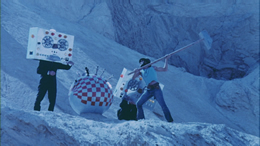
A long time
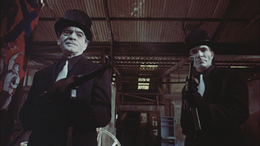 coming, Grindhouse Releasing's three-disc set is a comprehensive release that puts the majority of studio efforts to shame. In keeping with their lavish treatment of previous films like The Beyond, it comes packed with extras and a fine transfer of the film itself taken from the best surviving print. The 93-minute version bearing the title An American Hippie in Israel (with three different fonts in the opening credits!) is the default one on both the Blu-ray and DVD, which share the same extras as well. The transfer looks very good as usual, feeling like a product of the '70s without any excessive digital smudging to take away its scruffy ambience. The DTS-HD mono audio track on the Blu-ray (with optional Hebrew subtitles!) is the standard one, though you can also play the movie with a 5.1 mix of "The Beverly Cinema Experience" (complete with a raucous audience applauding and laughing throughout, a la Grindhouse's release of Pieces).
coming, Grindhouse Releasing's three-disc set is a comprehensive release that puts the majority of studio efforts to shame. In keeping with their lavish treatment of previous films like The Beyond, it comes packed with extras and a fine transfer of the film itself taken from the best surviving print. The 93-minute version bearing the title An American Hippie in Israel (with three different fonts in the opening credits!) is the default one on both the Blu-ray and DVD, which share the same extras as well. The transfer looks very good as usual, feeling like a product of the '70s without any excessive digital smudging to take away its scruffy ambience. The DTS-HD mono audio track on the Blu-ray (with optional Hebrew subtitles!) is the standard one, though you can also play the movie with a 5.1 mix of "The Beverly Cinema Experience" (complete with a raucous audience applauding and laughing throughout, a la Grindhouse's release of Pieces).Now on to the extras, starting with ten minutes of "controversial scenes deleted from the original release" including its original title sequence as The Hitchhiker. These are all basically scene extensions (with the actual amount of new footage being much smaller), including a longer version of the first sex scene, more painted guys, a different presentation of the Vietnam stock footage at the beginning, and more warehouse mayhem. Nine minutes of silent screen tests are basically the actors with different haircuts acting out a few scenes, with the highlight being a trial run for the, ahem, unforgettable finale.
A 2009 interview with Tzarfati (in English) and Wolf (in Hebrew with English subtitles) in Tel Aviv runs a whopping 56 minutes and sheds quite a bit of light on how this project came together, mainly through a series of friendships and recommendations to secure enough financing to get it off the ground. "This hippie status is based on artificiality" seems to be the closest we get to an explanation of the film's theme, and there's a lot of discussion of the film's first-time director, the late Amos Sefer. Perhaps the most startling sideline concerns whether the married Tzarfati really "screwed" Avidan, which leads into an eye-opening anecdote about Richard Harris and Romy Schneider! The whole shoot took about twelve days, which included exhausting marathon filming in the desert, resulting in a
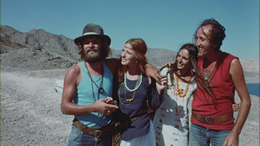 film that was "sweet and also funny." Wolf's stories about the film's rediscovery are great, too, so be sure to stick around to the end. Culled from the same interview session is the 17-minute "Asher Tzarfati - An Israeli Actor in Israel," with the chain-smoking actor talking more about his life experiences in front of the camera (including working with Menahem Golan) and the state of more recent national cinema like Waltz with Bashir. Sefer is represented with a text bio (which is pretty amazing by itself) and a 16mm short film, "Be Careful Children the Ball Is Not Just Yours," a six-minute silent amalgam of social statement and editing exercise contrasting playful kids with warships and soldiers. The four-minute "A Cult Is Born" interviews young Israeli fans at a cinematheque screening, enthusing about their multiple viewings and calling it "love at first sight" with "a strong Kubrick influence."
film that was "sweet and also funny." Wolf's stories about the film's rediscovery are great, too, so be sure to stick around to the end. Culled from the same interview session is the 17-minute "Asher Tzarfati - An Israeli Actor in Israel," with the chain-smoking actor talking more about his life experiences in front of the camera (including working with Menahem Golan) and the state of more recent national cinema like Waltz with Bashir. Sefer is represented with a text bio (which is pretty amazing by itself) and a 16mm short film, "Be Careful Children the Ball Is Not Just Yours," a six-minute silent amalgam of social statement and editing exercise contrasting playful kids with warships and soldiers. The four-minute "A Cult Is Born" interviews young Israeli fans at a cinematheque screening, enthusing about their multiple viewings and calling it "love at first sight" with "a strong Kubrick influence." 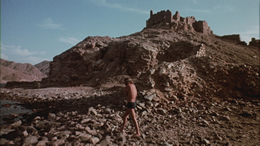 Apparently they really, really love dancing onstage, strapping on horned hats, and doing improvised songs while the film is playing, too. (Fans of that folk singer are in for a quick surprise, too, but more on her in a moment.) If Rocky Horror can inspire such dedication, why not this one, too?
Apparently they really, really love dancing onstage, strapping on horned hats, and doing improvised songs while the film is playing, too. (Fans of that folk singer are in for a quick surprise, too, but more on her in a moment.) If Rocky Horror can inspire such dedication, why not this one, too? An Israeli "Channel 10" segment also devotes ten minutes to the film's burgeoning midnight movie cult, with a reporter explaining how a cult film is created (with both Tzarfati and Wolf on hand, too). A four-minute interview with assistant production manager Moshe Berman goes much more in depth about the "sucker" who financed the film after answering Sefer's want ad, while a seven-minute chat with folk singer Susan Devore reveals her own unusual career path with singing duo "Susan & Fran" and has a magical Skype moment. "Shmuel's Still Show" returns to Wolf again for five minutes as he shows off a slew of black and white photos from the shoot, with a pair of traditional galleries for production stills and promotional materials also included next. Of course, the now-familiar Grindhouse Releasing trailer is also included along with bonus ones for Corruption, The Big Gundown, The Swimmer, Massacre Mafia Style, Gone with the Pope, Poor White Trash Part II, A Cat in the Brain, I Drink Your Blood, Pieces, and the glorious Death Game. Of course, since this is a Grindhouse title, keep an eye out for some very arbitrary Easter eggs as well.
As for that third disc included in the first pressing, it's a DVD of the original Israeli version of the film under the title The Hitchhiker, uncovered by Yaniv Eidelstein while he was hunting for the film at the Israel Film Archive. Featuring burned-in Hebrew and French subtitles (the same print shown at the film's midnight screenings in Israel), it's obviously in much rougher condition but worth checking out for curiosity value as it integrates the aforementioned deleted scenes back into the film proper, now running 94 minutes. An insert fold-out poster also features appreciative liner notes by John Skipp, wrapping up a cult movie release totally unlike any other.
Reviewed on September 4, 2013.
![]()